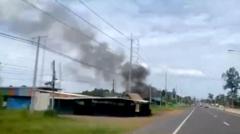Fighting erupted along the Thailand-Cambodia border on Thursday, amidst escalating tensions that have characterized the relationship between the two nations for over a century. Reports indicate that at least 12 Thai nationals, predominantly civilians, have lost their lives, while the number of casualties on the Cambodian side remains unclear.
The conflict traces back to the colonial era, when borders were drawn post-French occupation, leading to animosities that intensified in recent years. Hostilities officially began in 2008 when Cambodia sought UNESCO World Heritage status for an ancient temple in a disputed area—a request that was met with fierce resistance from Thailand. Sporadic skirmishes have since resulted in casualties on both sides, with the situation worsening in May after a Cambodian soldier was killed.
Earlier this week, the tensions reached a boiling point following accusations from both nations. Thailand claims Cambodia initiated hostilities by deploying armed troops and drones near the border. Conversely, Cambodian authorities allege that Thai forces escalated the conflict by encroaching on sacred sites and firing into Cambodian territory.
Troop presence along the border has increased, and both countries have enacted trade restrictions and border closures. Cambodia has also halted imports of Thai goods, including agricultural products and services, further straining relations.
Adding to the uncertainty, Thailand's acting premier said the dispute requires careful management, while Cambodia's Prime Minister emphasized the need for a peaceful resolution, though acknowledged the right to self-defense. Despite prior violent exchanges, expert opinions suggest that the conflict may not escalate into an outright war, but a delicate path towards de-escalation lies ahead.
Current travel advisories remain cautious but not alarming, alerting visitors to exercise extra care near the border following its recent closure. The situation continues to evolve, with both regional and international implications.






















